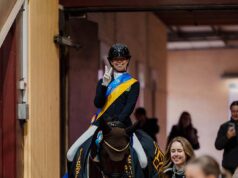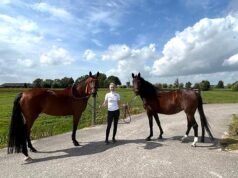By Agata Grosicka
Photography: Lukasz Kowalski
The second edition of the International Breeding Conference ‘How to raise success’ was organized on the last day of February 2020 by Cichon Stallions, in Radzionkow, Poland. Ahead of any coronavirus lock-downs, the event gathered together 250 breeders, as well as representatives from most of the European studbooks – including Hanoverian, Oldenburg, Holsteiner, AES, Danish Warmblood, Zangersheide – and, of course, Polish PZHK.
The first part of the conference was dedicated to lectures highlighting the different aspects of foal raising presented by Dr. Krzysztof Skorupski – a well known veterinarian and psychologist who lectured about ‘Psychology of a horse’s individual behavioral differences’. Aleksandra Nejman of Light Equitation discussed the importance of imprinting, and how to effciently work with a foal from birth to its preparation for a future sporting career. Dr. Katarzyna Marchewczyk from TA Praxis, Drs. Janetzko and Lange, discussed the major threats foals may encounter at a very young age, Finally, Dr. Paulina Wozniak of International Institute of Translational Medicine lectured on epigenetic regulations of bone mineral density.
Much anticipated was the presentation of Heinz Meier from Schockemoehle Pferdehaltung and Gestüt Lewitz, which generated a lively Q&A, which has been extracted below:
On national vs. global breeding: “Breeding is global with only one exception, the Trakhener Verband, which will sooner or later also become global. All the other Verbands are now open to horses of different breeds, and carry ‘open books’.”
On foal raising: “With a thousand horses every year in Gestüt Lewitz, it’s difficult to maintain a bond with a foal all the time, so those between the ages of one and two years lose the connection, which is later rebuilt individually at the age of three.”
On embryo transfer: “During the breeding season we use the best broodmares a couple of times, as the same gene combination is not repeatable. In breeding, one plus one never equals two, so embryo transfer makes success come faster.”
On the showjumping selection process: “With a thousand foals every year we make sure that 70% reach 1m40 competitions. The first selection comes right after birth, then at the age of 12 to 14 months we see them going through cavaletti, and finally, at the age of three, after a free jumping test, we make the decision whether to sell or keep the horse in our herd.”

On the broodmares: “We have over 1,000 broodmares and every year we rebuild our herd by choosing 50 new broodmares that are then used exlusively for embryo transfer in their first breeding seasons. After three years they give birth naturally once or twice, then either return to the embryo transfer program or are used for sport.”
On foal evaluation: “In their first days we can only evaluate their gaits; jumping comes later. In the case of dressage horses, =movement can be evaluated very early, and if based on natural type, these features are sure to stay.”
Christian Springborg, the young-horse manager from Helgstrand Dressage presented the By Ravnstrup Center in Denmark, a facility specially dedicated to raising young horses: “The foals come to us at the age of six months. The first winter is the most important period in their lives. You have to be with them all the time. We keep them in paddocks on concrete to ensure their hooves and tendons grow strong, and feed them lots of hay. Typically, out of of 80 foals we see only four or five who may be lame. The first selection comes at the age of one with the focus on type and gaits. During the following winter they’re outside to stimulate their growth and build their muscles. Training young horses has to be diverse, we loose jump them even if they’re dressage horses. They work three days a week, are lunged in a round pen, side reins. With young horses the resuts come very fast”.
Afternoon debate
The afternoon debate of studbooks was a long-awaited moment as it gathered together a number of luminaries: From the Hanoverian Verband, Maren Schlender, deputy breeding manager ‘breeding abroad, seminars for breeders, and Piotr Kuczynski, Polish representative; André Hahn, deputy breeding director of the Oldenburg Verband; Roland Metz, auction and marketing manager from the Holsteiner Verband; Eva-Maria Broomer and Joanna Rosicka-Tyszko from AES; Joanna Banas from Zangersheide Polska; and last but not the least, Janusz Lewandowski from PZHK... To read the complete article you need to be a subscriber
CLICK HERE TO SUBSCRIBE TO BREEDING NEWS
SUBSCRIBERS CAN READ THE COMPLETE ARTICLE BY LOGGING IN AND RETURNING TO THIS PAGE




